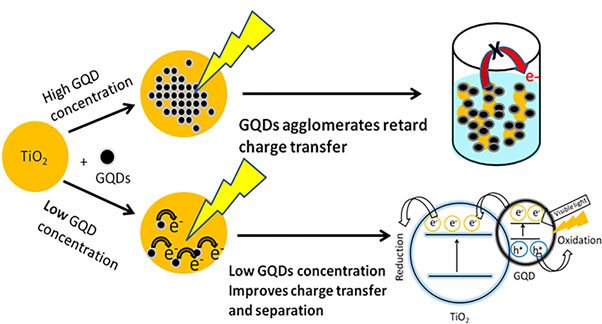Crossref Citations
This article has been cited by the following publications. This list is generated based on data provided by
Crossref.
Tian, P.
Tang, L.
Teng, K.S.
and
Lau, S.P.
2018.
Graphene quantum dots from chemistry to applications.
Materials Today Chemistry,
Vol. 10,
Issue. ,
p.
221.
Regulska, Elzbieta
Breczko, Joanna
and
Basa, Anna
2019.
Pristine and Graphene-Quantum-Dots-Decorated Spinel Nickel Aluminate for Water Remediation from Dyes and Toxic Pollutants.
Water,
Vol. 11,
Issue. 5,
p.
953.
Parangi, Tarun
and
Mishra, Manish Kumar
2019.
Titania Nanoparticles as Modified Photocatalysts: A Review on Design and Development.
Comments on Inorganic Chemistry,
Vol. 39,
Issue. 2,
p.
90.
Lee, Hanuk
Anwer, Hassan
and
Park, Jae-Woo
2020.
Graphene quantum dots on stainless-steel nanotubes for enhanced photocatalytic degradation of phenanthrene under visible light.
Chemosphere,
Vol. 246,
Issue. ,
p.
125761.
Mustafa, Muhammad Norhaffis
and
Sulaiman, Yusran
2020.
Optimization of titanium dioxide decorated by graphene quantum dot as a light scatterer for enhanced dye-sensitized solar cell performance.
Journal of Electroanalytical Chemistry,
Vol. 876,
Issue. ,
p.
114516.
Anas, Nur Ain Asyiqin
Fen, Yap Wing
Yusof, Nor Azah
Omar, Nur Alia Sheh
Daniyal, Wan Mohd Ebtisyam Mustaqim Mohd
and
Ramdzan, Nur Syahira Md
2020.
Highly sensitive surface plasmon resonance optical detection of ferric ion using CTAB/hydroxylated graphene quantum dots thin film.
Journal of Applied Physics,
Vol. 128,
Issue. 8,
p.
083105.
Raghavan, Akshaya
Sarkar, Suprabhat
Nagappagari, Lakshmana Reddy
Bojja, Sreedhar
MuthukondaVenkatakrishnan, Shankar
and
Ghosh, Sutapa
2020.
Decoration of Graphene Quantum Dots on TiO2 Nanostructures: Photosensitizer and Cocatalyst Role for Enhanced Hydrogen Generation.
Industrial & Engineering Chemistry Research,
Vol. 59,
Issue. 29,
p.
13060.
Kadian, Sachin
and
Manik, Gaurav
2020.
A highly sensitive and selective detection of picric acid using fluorescent sulfur‐doped graphene quantum dots.
Luminescence,
Vol. 35,
Issue. 5,
p.
763.
Xue, Jiayan
Long, Lizhen
Zhang, Lin
Luo, Hongtian
Yang, Li
Liu, Fuchi
Lv, Fengzhen
Kong, Wenjie
and
Liu, Jun
2020.
Enhanced H2 evolution and the interfacial electron transfer mechanism of titanate nanotube sensitized with CdS quantum dots and graphene quantum dots.
International Journal of Hydrogen Energy,
Vol. 45,
Issue. 11,
p.
6476.
Rasuli, Hadi
Rasuli, Reza
Alizadeh, Mahdi
and
BoonTong, Goh
2020.
Microwave-assisted exfoliation and tearing of graphene oxide in the presence of TiO2 nanoparticles.
Results in Physics,
Vol. 18,
Issue. ,
p.
103200.
Najeeb, Mansoor Ani
Ahmad, Zubair
Balamurugan, Sarkarainadar
Sulaiman, Khaulah
and
Shakoor, R.A.
2020.
A Short Analysis on the Morphological Characterization of Colloidal Quantum Dots for Photovoltaic Applications.
Current Nanoscience,
Vol. 16,
Issue. 4,
p.
544.
Tshangana, Charmaine S.
Muleja, Adolph A.
Kuvarega, Alex T.
Malefetse, Tshepo J.
and
Mamba, Bhekie B.
2021.
The applications of graphene oxide quantum dots in the removal of emerging pollutants in water: An overview.
Journal of Water Process Engineering,
Vol. 43,
Issue. ,
p.
102249.
Bokare, Anuja
Arif, Jehanzeb
and
Erogbogbo, Folarin
2021.
Strategies for Incorporating Graphene Oxides and Quantum Dots into Photoresponsive Azobenzenes for Photonics and Thermal Applications.
Nanomaterials,
Vol. 11,
Issue. 9,
p.
2211.
Jauja-Ccana, V.R.
Córdova Huamán, Allison V.
Feliciano, Gustavo T.
and
La Rosa-Toro Gómez, Adolfo
2021.
Optical and electronic properties of TiO2/GOQDs composites: A combined experimental and first-principles calculations study.
Computational Materials Science,
Vol. 195,
Issue. ,
p.
110503.
Jauja-Ccana, V.R.
Cordova-Huaman, Allison V.
Feliciano, Gustavo T.
and
La Rosa-Toro Gómez, Adolfo
2021.
Experimental and molecular dynamics study of graphene oxide quantum dots interaction with solvents and its aggregation mechanism.
Journal of Molecular Liquids,
Vol. 335,
Issue. ,
p.
116136.
Bokare, Anuja
and
Erogbogbo, Folarin
2021.
Photocatalysis and Li-Ion Battery Applications of {001} Faceted Anatase TiO2-Based Composites.
J,
Vol. 4,
Issue. 3,
p.
500.
Kumar, Lakhan
Ragunathan, Venkataraghavan
Chugh, Mohita
and
Bharadvaja, Navneeta
2021.
Nanomaterials for remediation of contaminants: a review.
Environmental Chemistry Letters,
Vol. 19,
Issue. 4,
p.
3139.
Bokare, Anuja
Chinnusamy, Sowbaranigha
and
Erogbogbo, Folarin
2021.
TiO2-Graphene Quantum Dots Nanocomposites for Photocatalysis in Energy and Biomedical Applications.
Catalysts,
Vol. 11,
Issue. 3,
p.
319.
Huo, Peipei
Shi, Xiaobo
Zhang, Wenyu
Kumar, Parveen
and
Liu, Bo
2021.
An overview on the incorporation of graphene quantum dots on TiO2 for enhanced performances.
Journal of Materials Science,
Vol. 56,
Issue. 10,
p.
6031.
Ma, Jing
Chu, Lihua
Guo, Yanjiao
Sun, Changxu
Yan, Hao
Li, Ze
and
Li, Meicheng
2021.
Graphene Quantum Dots Improved “Caterpillar”-like TiO2 for Highly Efficient Photocatalytic Hydrogen Production.
Materials,
Vol. 14,
Issue. 18,
p.
5354.





